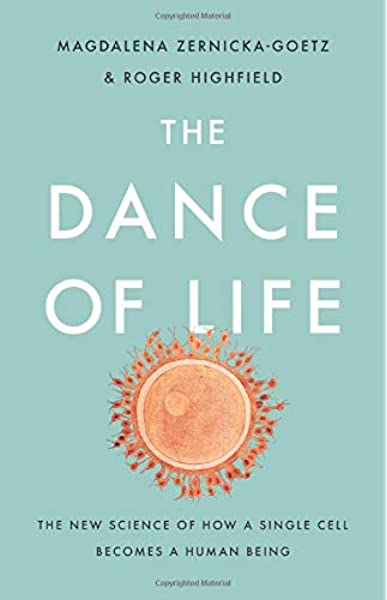
Advent is a season of waiting. We remember the specific anticipation of Mary & Joseph for their son and the more abstract anticipation for justice and restoration, represented by Simeon and Anna. While Jesus would inaugurate a new era of redemption, we share in the longing of Simeon and Anna as we recognize that justice is still not equally distributed and creation is not fully restored. While expressing that longing in different terms, Magdalena Zernicka-Goetz and Roger Highfield discuss outstanding needs for justice and healing in The Dance of Life.
Naturally, a book on developmental biology is focused on reproductive health and the health of newly developing life. One of the final chapters of The Dance of Life surveys the landscape of biomedical applications of developmental biology research, not just from Zernicka-Goetz’ lab but also many other teams of scientists. I know Christians have different approaches to in vitro fertilization and other reproductive health treatments. At the same time, even many conservative individuals and organizations have managed to positively engage with such procedures in a way they find morally acceptable. And so I expect many will find common ground with Zernicka-Goetz in appreciating the potential for this science to help more couples be fruitful and multiply.
The Dance of Life also confronts the ethical challenges of research involving human embryos. American readers should note that Zernicka-Goetz has done most of her research in the United Kingdom, where the legal boundaries are different (but far from lax). While some of you may disagree with her (and UK lawmakers) on the proper line to draw around human embryo research, hopefully we can all appreciate that Zernicka-Goetz is serious and conservative–in favor of change only when clearly necessary and in careful increments–in her approach to ethical considerations. She professes a deep respect for all life and does not permit her students and collaborators to be wasteful even of mouse embryos for the sake of expediency. I hope we could all see her as more of an ally in seeking justice for human life in its most nascent form.

The other matter of justice Zernicka-Goetz is passionate about is equal treatment of women in science and academia. In a week when an American newspaper with national circulation saw fit to publish an open letter-style op-ed asking a woman to stop using an honorific she has earned, I cannot imagine trying to argue that women face no bias in higher education. The Dance of Life briefly discusses more data than my single anecdote. In the main, though, the book is less interested in proving there is a problem and more interested in demonstrating a better way forward. Zernicka-Goetz is clearly a committed mentor and highlights contributions from many students and researchers who have worked with her. Not all of these folks are women; there is no sense that men must be slighted for women to get better opportunities. Nevertheless, she highlights the unique skills and insights of multiple scientists who are women along the way, thus providing a more comprehensive picture of who is and has been contributing to science all along.
Zernicka-Goetz’ own story is an illustration of why a concern for representation is not merely about numbers for numbers’ sake. As we discussed last week, one branch of her research program was inspired by her experience as an expectant mother. Now, you don’t have to be pregnant to ask the questions she was asking and you certainly don’t have to be pregnant or a woman to do the work to answer those questions. But there are far more research questions that could potentially be studied than there is grant funding or scientist time to investigate. And our different experiences do prompt us to ask and prioritize different questions. So if significant groups are not part of the community asking and answering (and funding) those questions, certain paths may never get explored at all.
Equality of representation in the sciences may not be the sort of justice issue we normally think about during Advent. And to be sure, there are plenty of other worthy needs and causes to spend time and resources on at this time. Still, I appreciated the opportunity to get another perspective on where justice is needed and how to bring more.
Andy has worn many hats in his life. He knows this is a dreadfully clichéd notion, but since it is also literally true he uses it anyway. Among his current metaphorical hats: husband of one wife, father of two teenagers, reader of science fiction and science fact, enthusiast of contemporary symphonic music, and chief science officer. Previous metaphorical hats include: comp bio postdoc, molecular biology grad student, InterVarsity chapter president (that one came with a literal hat), music store clerk, house painter, and mosquito trapper. Among his more unique literal hats: British bobby, captain’s hats (of varying levels of authenticity) of several specific vessels, a deerstalker from 221B Baker St, and a railroad engineer’s cap. His monthly Science in Review is drawn from his weekly Science Corner posts — Wednesdays, 8am (Eastern) on the Emerging Scholars Network Blog. His book Faith across the Multiverse is available from Hendrickson.

Andy, Thank you for bringing “The Dance of Life” to my attention. I particularly appreciated the dialogue with Advent and how the publication offers next steps in justice. As I adjust to a ministry season with less time to read publications, I’ll continue to check back to what is highlighted on the Emerging Scholars Network blog. Keep pressing on in the upward hope of Christ Jesus. To God be the glory!